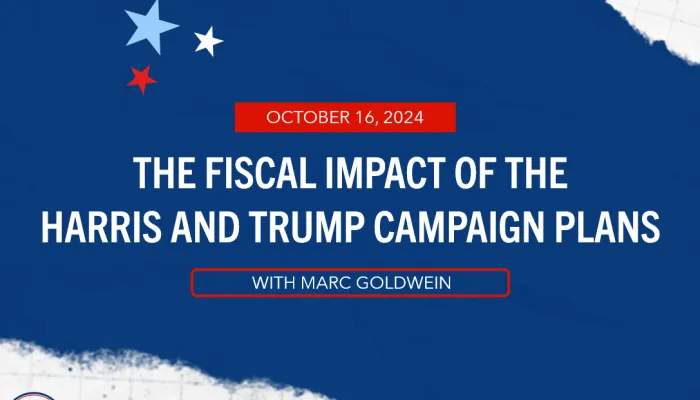The Impact of the Trump and Harris Plans on Spending and Revenue
In our recent analysis, The Fiscal Impact of the Harris and Trump Campaign Plans, we found that the campaign policy plans from both Vice President Kamala Harris and former President Donald Trump would likely expand budget deficits and grow debt faster than under current law if implemented.
In terms of how the plans would affect federal spending and revenues, Vice President Harris’s plan would keep revenue near current law projected levels while boosting spending; President Trump’s plan would keep primary (non-interest) spending near current law projected levels while reducing revenues. Both candidates would boost interest costs, total deficits and debt – Trump moreso.1
Spending and Revenue Effects of the Harris and Trump Plans (% of GDP)
| Primary Spending | Total Spending | Revenue | Total Deficit | Debt | |
|---|---|---|---|---|---|
| Harris (2035) | 21.8% | 26.2% | 18.1% | 8.1% | 133% |
| Trump (2035) | 21.0% | 25.7% | 16.1% | 9.6% | 142% |
| Current Law (2035) | 20.9% | 25.1% | 18.0% | 7.0% | 125% |
| Current Fiscal Year (2025) | 20.1% | 23.5% | 17.0% | 6.5% | 102% |
| 50-Year Historical Average (1974-2023) | 19.0% | 21.0% | 17.3% | 3.7% | 48% |
US Budget Watch 2024 is a project of the nonpartisan Committee for a Responsible Federal Budget designed to educate the public on the fiscal impact of presidential candidates’ proposals and platforms. Throughout the election, we will issue policy explainers, fact checks, budget scores, and other analyses. We do not support or oppose any candidate for public office.
Under the Congressional Budget Office’s (CBO) current law baseline, primary (non-interest) spending is projected to grow from 20.1 percent of Gross Domestic Product (GDP) in Fiscal Year (FY) 2025 to 20.9 percent in 2035, and total spending is projected to rise from 23.5 percent of GDP in 2025 to 25.1 percent of GDP in 2035.
Under Harris’s plan, we estimate primary spending would rise to 21.8 percent of GDP in FY 2035 – nearly a percentage point above current law – and total spending would rise to 25.7 percent. Vice President Harris’s new spending proposals and the refundable portion of her tax proposed tax credit expansions would increase spending well above current law.
Under Trump’s plan, we estimate primary spending would rise to about 21.0 percent of GDP in FY 2035 – in line with current law – while total spending would rise above current law levels to 25.7 percent. President Trump’s proposed spending increases and cuts would roughly cancel.
All three of these scenarios would bring spending well above its historic average of 21 percent of GDP from 1974 to 2023, and all three would bring primary spending to well above its historic average of 19 percent of GDP over that same period.

On the tax side, CBO projects revenue will rise from 17.0 percent of GDP in FY 2025 to 18.0 percent in 2035 under current law, with the growth coming mostly from the expiration of large parts of the 2017 Tax Cuts & Jobs Act (TCJA).
Under Harris’s plan, we estimate revenue would track current law relatively closely, rising to 18.1 percent of GDP in FY 2035. Proposed tax increases under her plan would mostly go to fund the extension of the TCJA for households making less than $400,000 a year, along with some additional tax cuts.
Under Trump’s plan, revenue would fall to 16.1 percent of GDP in FY 2035 rather than rising to 18.0. The combined budget impact of his proposal to extend and modify the TCJA, along with several large new tax cuts, would be significantly higher than the revenue generated from increased tariffs and reduced energy tax breaks.
Revenue under current law and the Harris plan would be somewhat above the historical average of 17.3 percent of GDP from 1974 to 2023, while revenue under the Trump plan would be significantly below that historic average.

Both candidates’ plans would widen budget deficits – Harris’s plan mainly by boosting primary spending and Trump’s plan mainly by reducing revenue. Both plans would also boost interest costs. Because Trump’s net tax cuts are larger than Harris’s net spending increases, his plan would boost deficits more than twice as much as Harris's plan by FY 2035.
While deficits would rise from 6.5 to 7.0 percent of GDP by FY 2035 under current law, they would rise to 8.1 percent under the Harris plan and 9.6 percent under the Trump plan. These would represent record deficit levels outside of a war, pandemic, or recession, and would push the debt to new record levels as a share of the economy.
1 All numbers in this analysis are based on our central estimate of the candidates plans in The Fiscal Impact of the Harris and Trump Campaign Plans. Our analysis uses rules of thumb to classify policy areas as spending, revenue, or some combination of the two. Although immigration affects revenue, spending, and GDP, we count the net effect entirely on the revenue side to maximize comparability of numbers.


